International Journal of Computer Network and Information Security @ijcnis
Статьи журнала - International Journal of Computer Network and Information Security
Все статьи: 1166
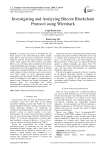
Investigating and analyzing bitcoin blockchain protocol using wireshark
Статья научная
A bitcoin node needs to download the full block contents of the entire blockchain, before actually being able to send and receive transactions on bitcoin broadcast network, except simple payment verification clients which require only block headers and bloom filters to sync with others peers available on the network. Transactions/Blocks pass through a complex process at sender and receiver than it apparently looks to be. During transmission transactions/blocks are broken down into smaller chunks of data so that they can be carried on the wire. These chunks are given appropriate headers, encapsulated and then passed through several layers to reach the destination. In this paper we captured Bitcoin packets using Wireshark and deeply investigated and analyzed them. We investigated how bitcoin transaction/block messages work and what values and parameters are considered during this whole process.
Бесплатно
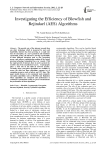
Investigating the Efficiency of Blowfish and Rejindael (AES) Algorithms
Статья научная
The growth rate of the internet exceeds than any other technology which is measured by users and bandwidth. Internet has been growing at a rapid rate since its conception, on a curve geometric and sometimes exponential. Today, the Internet is moving exponentially in three different directions such as size, processing power, and software sophistication making it the fastest growing technology humankind has ever created. With the rapid growth of internet, there is need to protect the sensitive data from unauthorized access. Cryptography plays a vital role in the field of network security. Currently many encryption algorithms are available to secure the data but these algorithms consume lot of computing resources such as battery and CPU time. This paper mainly focuses on two commonly used symmetric encryption algorithms such as Blowfish and Rejindael. These algorithms are compared and performance is evaluated. Experimental results are given to demonstrate the performance of these algorithms.
Бесплатно
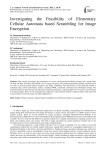
Investigating the Feasibility of Elementary Cellular Automata based Scrambling for Image Encryption"
Статья научная
This research investigates the performance of various one-dimensional cellular automata rules, namely Rule 30, Rule 150, Rule 184, Rule 105 and Rule 110, for image encryption. The proposed algorithm technique combines these CA rules to generate pseudo-random sequences for image scrambling. The effectiveness of the proposed method is evaluated using various performance metrics, including NPCR, correlation coefficient and information entropy. The results demonstrate which rule provides the best encryption performance, achieving high levels of security and resistance to statistical attacks. However, the computational complexity of the proposed method is relatively high, which may limit its practicality for real-time image encryption applications.
Бесплатно
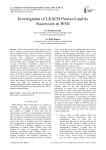
Investigation of LEACH Protocol and its Successors in WSN
Статья научная
Sensor nodes present in WSN plays its crucial role in sensing, processing and communicating data in brutal conditions. Power source like battery is required by these nodes for energy, which got sucked out in the processes like aggregation, compression and communication of sensed data. Extensive flaws seen now days are energy source constraints. After deploying nodes in nasty environment, worthwhile a battery is not rehabilitate. Therefore, proliferate usage of energy to enhance network lifetime is main issue. To clear up this trouble various clustering techniques are popularized. In clustering, sensor nodes group together to generate small clusters and CH is elected for aggregating data coming from cluster members. For large networks, hierarchical clustering model is applicable to assemble data at every cluster and transmit that processed data to the base station. This phase out repetitious data to be communicated which further curtail energy consumption. Various LEACH protocols are discussed in this review to enhance network lifetime.
Бесплатно

Investigations of Cellular Automata Linear Rules for Edge Detection
Статья научная
Edge detection of images is one of the basic and most significant operations in image processing and is used for object background separation, 3-D interpretation of a 2-D image, and pre-processing in image understanding and recognition algorithms. In this paper we investigate cellular automata linear rules for edge detection and based on this investigation we have classified the rules into no edge detection rules, strong edge detection rules and weak edge detection rules. Finally, we show the comparative analysis of the proposed technique with already defined techniques for edge detection and the results show desirable performance.
Бесплатно
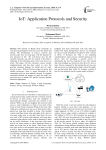
IoT: application protocols and security
Статья научная
The Internet of Things (IoT) commands an ever-growing population of devices across the nation and abroad. The development of privacy concerns and security goals have not kept pace with the demand for new advances in IoT. We will discuss how the IoT currently functions and why the security in this field is important as the technology grows into every device we touch. This paper will also reference current security implementations and how they expect to cover this growing consumer demand for instant data on many devices at once. With IoT devices using less power and smaller processors, there is major discussion in the computing world on what methods succeed. As standard encryption methods are simply too much for small, low power devices to handle; IoT specific security methods should be highlighted.
Бесплатно
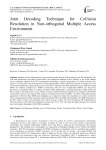
Joint Decoding Technique for Collision Resolution in Non-orthogonal Multiple Access Environment
Статья научная
Multiple access technologies have grown hand in hand from the first generation to the 5th Generation (5G) with both performance and quality improvement. Non-Orthogonal Multiple Access (NOMA) is the recent multiple access technology adopted in the 5G communication technology. Capacity requirements of wireless networks have grown to a large extent with the penetration of ultra-high-definition video transmission, Internet of Things (IoT), and virtual reality applications taking ground in the recent future. This paper develops the Physical Layer Network Coding (PNC) for collision resolution in a NOMA environment with two users. Traditionally NOMA uses Successive Interference Cancellation (SIC) for collision resolution. While additionally a decoding algorithm is added along with SIC to improve the performance of the collision resolution. MATLAB-based simulation is developed on the NOMA environment with two users using Viterbi coding, Low-Density Parity Check (LDPC), and Turbo coding. Performance parameters of Bit Error Rate (BER) and throughput are compared for these three algorithms. It is observed that the Turbo coding performed better among these three algorithms both in the BER and throughput. The BER obtained from the SIC- Turbo is found to be performing well with an increase of about 14% from the ordinary SIC implementation. The performance of the collision resolution has increased by 13% to 14% when joint decoding techniques are used and thus increasing the throughput of the NOMA paradigm.
Бесплатно
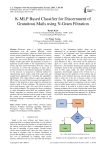
K-MLP Based Classifier for Discernment of Gratuitous Mails using N-Gram Filtration
Статья научная
Electronic spam is a highly concerning phenomenon over the internet affecting various organisations like Google, Yahoo etc. Email spam causes several serious problems like high utilisation of memory space, financial loss, degradation of computation speed and power, and several threats to authenticated account holders. Email spam allows the spammers to deceit as a legitimate account holder of the organisations to fraud money and other useful information from the victims. It is necessary to control the spreading of spam and to develop an effective and efficient mechanism for defence. In this research, we proposed an efficient method for characterising spam emails using both supervised and unsupervised approaches by boosting the algorithm's performance. This study refined a supervised approach, MLP using a fast and efficient unsupervised approach, K-Means for the detection of spam emails by selecting best features using N-Gram technique. The proposed system shows high accuracy with a low error rate in contrast to the existing technique. The system also shows a reduction in vague information when MLP was combined with K-Means algorithm for selecting initial clusters. N-Gram produces 100 best features from the group of data. Finally, the results are demonstrated and the output of the proposed technique is examined in contrast to the existing technique.
Бесплатно
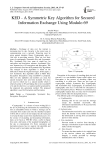
KED - A Symmetric Key Algorithm for Secured Information Exchange Using Modulo 69
Статья научная
Exchange of data over the internet is increasing day by day. Security is the main issue in communication over a network. Protection must be given against intruders. Hence Cryptography plays a vital role in providing security. There are two basic types of cryptography: Symmetric Key and Asymmetric Key. Symmetric Key uses same or single key for encryption and decryption whereas Asymmetric Key uses separate keys for encryption and decryption. The most commonly used are the Symmetric Key algorithms. The strength of these algorithms is based on the difficulty to break the original messages. In this paper, a new Symmetric Key algorithm called as KED (Key Encryption Decryption) using modulo69 is proposed. Here not only alphabets and numbers are used, but special characters have also been included. Two keys are used in which one is a natural number which is relatively prime to 69 and finding the inverse modulo69 of it and the other key is a random number generated by the proposed key generation method. The proposed algorithm is used for Encryption and Decryption.
Бесплатно
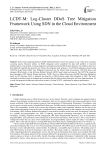
LCDT-M: Log-Cluster DDoS Tree Mitigation Framework Using SDN in the Cloud Environment
Статья научная
In the cloud computing platform, DDoS (Distributed Denial-of-service) attacks are one of the most commonly occurring attacks. Research studies on DDoS mitigation rarely considered the data shift problem in real-time implementation. Concurrently, existing studies have attempted to perform DDoS attack detection. Nevertheless, they have been deficient regarding the detection rate. Hence, the proposed study proposes a novel DDoS mitigation scheme using LCDT-M (Log-Cluster DDoS Tree Mitigation) framework for the hybrid cloud environment. LCDT-M detects and mitigates DDoS attacks in the Software-Defined Network (SDN) based cloud environment. The LCDT-M comprises three algorithms: GFS (Greedy Feature Selection), TLMC (Two Log Mean Clustering), and DM (Detection-Mitigation) based on DT (Decision Tree) to optimize the detection of DDoS attacks along with mitigation in SDN. The study simulated the defined cloud environment and considered the data shift problem during the real-time implementation. As a result, the proposed architecture achieved an accuracy of about 99.83%, confirming its superior performance.
Бесплатно
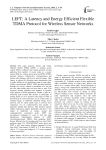
LEFT: A Latency and Energy Efficient Flexible TDMA Protocol for Wireless Sensor Networks
Статья научная
This paper proposes latency and energy efficient flexible TDMA (LEFT), a medium access control (MAC) combined with routing protocol for data gathering from number of source nodes to a master station (MS) in a wireless sensor network (WSN). TDMA provides fairness, collision-free communication and reduces idle listening, which saves network energy. Data latency is reduced by allocating same transmission slots to nodes falling out of interference range of each other. Unlike a conventional TDMA, LEFT provides flexibility through slot seizing, wherein a non-holder of a slot can use slot when holder does not have data to send. This increases channel utilization and adaption to dynamic traffic patterns of WSN applications. Further, a node on a multi-hop path towards MS decides to participate in routing based on (i) its location with respect to MS, to forward data in correct direction, (ii) its current status of residual energy, to uniformly distribute energy across network, (iii) its transit traffic load, to prevent local congestion, (iv) its communication link quality, to guarantee reliable data delivery. This decision requires simple comparisons against thresholds, and thus is very simple to implement on energy, storage and computationally constrained nodes. LEFT also encompasses techniques to cater to link and node breakdowns. Experimental analysis of LEFT; Advertisement-based TDMA; Data gathering MAC; Energy Efficient Fast Forwarding and Cross layer MAC protocols using TI's EZ430-RF2500T nodes shows that LEFT is 65% more energy efficient compared to Cross layer MAC. Data latency of LEFT is 27 % less, delivery ratio is 17 % more and goodput is 11 % more compared to Cross layer MAC.
Бесплатно
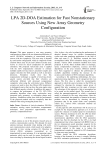
LPA 2D-DOA Estimation for Fast Nonstationary Sources Using New Array Geometry Configuration
Статья научная
This paper proposes a new array geometry configuration to improve the two dimensional direction of arrival (2D-DOA) estimation of narrowband moving sources with less complexity. This new array is denoted by verticircular configuration, which is composed of both Uniform linear array (ULA) and Uniform Circular array (UCA) to avoid too much computation for 2D-DOA estimation. The proposed verticircular array is applied with the LPA nonparametric estimator to estimate multiple rapidly moving sources’ parameters (angles and angular velocities) for both azimuth as well as elevation directions. Simulation results show that this nonparametric technique is capable of resolving closely spaced sources provided that their velocities are sufficiently different with decreased computational complexity when using the verticircular array. Different scenarios are used to show the efficient LPA beamformer to distinguish sources that can have the same angles using their different angular velocities. In addition, this paper is to compare the performance of the 2D- LPA DOA estimation algorithm when using verticircular array (proposed array geometry) or rectangular planar array geometry. Simulation results show that the performance of the proposed method with less complexity than that obtained when using rectangular planar array.
Бесплатно
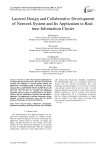
Статья научная
In order to achieve the integrated optimization in developing the big network system, this paper presented the concepts and principles of layered design method and collaborative development using of different tools firstly. Then we gave a recommended layered architecture for the distributed computing network system and also analyzed its pros and cons. At last, we extended the distributed computing network system to an information server cluster based on the task scheduling of dynamic and self-adaptive algorithm. The application of real-time information system designed by layered architecture shows that the method proposed in this paper is practical and efficient.
Бесплатно
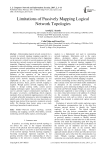
Limitations of Passively Mapping Logical Network Topologies
Статья научная
Understanding logical network connectivity is essential in network topology mapping especially in a fast growing network where knowing what is happening on the network is critical for security purposes and where knowing how network resources are being used is highly important. Mapping logical communication topology is important for network auditing, network maintenance and governance, network optimization, and network security. However, the process of capturing network traffic to generate the logical network topology may have a great influence on the operation of the network. In hierarchically structured networks such as control systems, typical active network mapping techniques are not employable as they can affect time-sensitive cyber-physical processes, hence, passive network mapping is required. Though passive network mapping does not modify or disrupt existing traffic, current passive mapping techniques ignore many practical issues when used to generate logical communication topologies. In this paper, we present a methodology which compares topologies from an idealized mapping process with what is actually achievable using passive network mapping and identify some of the factors that can cause inaccuracies in logical maps derived from passively monitored network traffic. We illustrate these factors using a case study involving a hierarchical control network.
Бесплатно
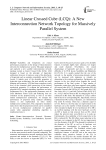
Linear Crossed Cube (LCQ): A New Interconnection Network Topology for Massively Parallel System
Статья научная
Scalability and Complexity are crucial performance parameters in the design of Interconnection networks for multiprocessor system. This paper proposed and analyzed a new scalable interconnection network topology named as Linear Crossed Cube (LCQ). LCQ designed is based on the principle of hypercube architecture however, it improves some of the drawbacks of hypercube such as complex extensibility and its VLSI Layout. It inherits most of the desirable properties of hypercube type architectures; the most notably are small diameter and symmetry. LCQ has linear extension at each level of the extension while preserving all the desired topological properties. To evaluate the performance of proposed LCQ, standard scheduling algorithms are being implemented on it. The performance parameters such as Load Imbalance Factor (LIF) and balancing time are evaluated on the proposed LCQ as well as on other similar multiprocessor architectures. To compare the performance of proposed LCQ, standard scheduling scheme is also implemented on other similar multiprocessor architectures. The comparative simulation study shows that the proposed network can be considered as low-cost multiprocessor architecture for parallel system when appropriate scheduling algorithm is implemented onto it.
Бесплатно
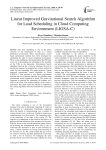
Статья научная
The load scheduling is one of the prime concerns for the computation of tasks in a virtual distributed environment. Many meta-heuristic swarm based optimization methods have been developed for scheduling the load in cloud computing environment. These swarm intelligence based algorithms like PSO play a key role in determining the scheduling of the cloudlets on the VMs in the datacenter. Gravitational Search algorithm based on law of gravity schedules the load in an effective manner. Its potential has not been utilized in cloud for load scheduling. This paper proposes a linear improved gravitational search algorithm in Cloud (LIGSA-C). This presents a new linear gravitational function and cost evaluation function for cloudlets using gravitational search approach in cloud. The results are computed by particles for scheduling 10 cloudlets on 8 VMs in the cloud. The detailed analysis of the result is performed. This paper states that LIGSA-C outperforms the existing algorithms like GSA and PSO for minimized cost.
Бесплатно
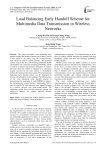
Load Balancing Early Handoff Scheme for Multimedia Data Transmission in Wireless Networks
Статья научная
This study developed a load balancing early handoff scheme that enables transfer part of heavy load in a base station to the others using the overlap between base stations in wireless cellular networks. The proposed scheme reduces the new call blocking probability (CBP) and handoff call connection dropping probability (CDP) as well as to increase the resource utilization of wireless networks. Since the scheme is triggered by a connection request received by the base station, it immediately reflects the loading of the base station. The proposed load balancing early handoff policy can be integrated in diverse call admission control schemes. The effectiveness of the load balancing early handoff scheme is demonstrated by integrating it with DMTBR to improve the call admission control function. Additionally, NS2 is used to simulate the load balancing early handoff scheme in a wireless network with wrap-around model. The simulation results show that the proposed scheme can effectively improve the wireless network resource utilization.
Бесплатно
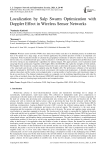
Localization by Salp Swarm Optimization with Doppler Effect in Wireless Sensor Networks
Статья научная
Wireless sensor networks (WSNs) have lately been widely used due to its abundant practice in methods that have to be spread over a large range. In any wireless application, the position precision of node is an important core component. Node localization intends to calculate the geographical coordinates of unknown nodes by the assistance of known nodes. In a multidimensional space, node localization is well-thought-out as an optimization problem that can be solved by relying on any metaheuristic’s algorithms for optimal outputs. This paper presents a new localization model using Salp Swarm optimization Algorithm with Doppler Effect (LOSSADE) that exploit the strengths of both methods. The Doppler effect iteratively considers distance between the nodes to determine the position of the nodes. The location of the salp leader and the prey will get updated using the Doppler shift. The performance validation of the presented approach simulated by MATLAB in the network environment with random node deployment. A detailed experimental analysis takes place and the results are investigated under a varying number of anchor nodes, and transmission range in the given search area. The obtained simulation results are compared over the traditional algorithm along with other the state-of-the-art methods shows that the proposed LOSSADE model depicts better localization performance in terms of robustness, accuracy in locating target node position and computation time.
Бесплатно
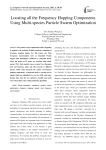
Locating all the Frequency Hopping Components Using Multi-species Particle Swarm Optimization
Статья научная
The particle swarm optimization (PSO) algorithm is applied to the problem of blind parameter estimation of frequency hopping signals. For this target, one Time Frequency representation such as Smoothed Pseudo Wigner-Ville Distribution (SPWVD) is computed firstly. Then, the peaks on TF plane are searched using multi-species PSO. Each particle moves around two dimension time and frequency plane and will converge to different species, which seeds represent the centers of frequency hopping components. A numerical study is carried out for signals which are embedded in a very low SNR ratio noise. Results show that the new method is feasible and much more robust than some existing estimation algorithms.
Бесплатно
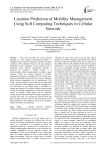
Location Prediction of Mobility Management Using Soft Computing Techniques in Cellular Network
Статья научная
This work describes the neural network technique to solve location management problem. A multilayer neural model is designed to predict the future prediction of the subscriber based on the past predicted information of the subscriber. In this research work, a prediction based location management scheme is proposed for locating a mobile terminal in a communication without losing quality maintains a good response. There are various methods of location management schemes for prediction of the mobile user. Based on individual characteristic of the user, prediction based location management can be implemented. This work is purely analytical which need the past movement of the subscriber and compared with the simulated one. The movement of the mobile target is considered as regular and uniform. An artificial neural network model is used for mobility management to reduce the total cost. Single or multiple mobile targets can be predicted. Among all the neural techniques multilayer perceptron is used for this work. The records are collected from the past movement and are used to train the network for the future prediction. The analytical result of the prediction method is found to be satisfactory.
Бесплатно

